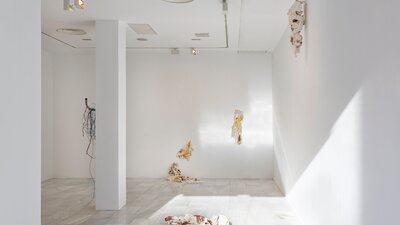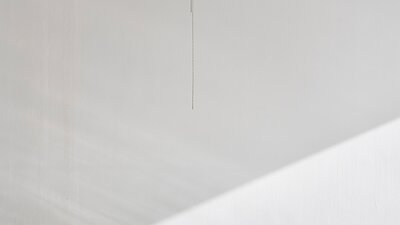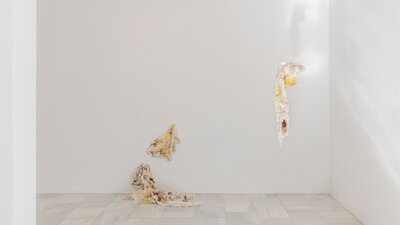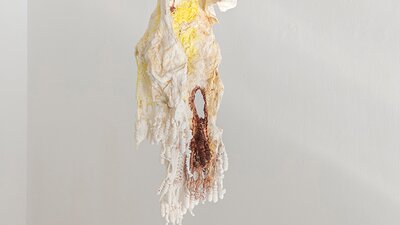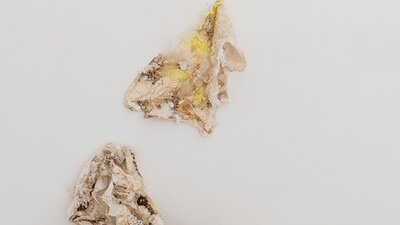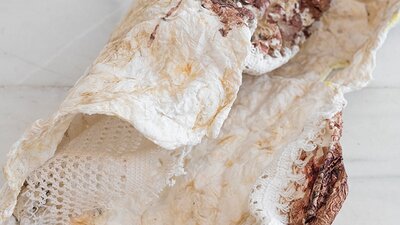matadero madrid
1st edition - 2022/2023
september to november 2022
La Escocesa
tangles that lick my skin
maya pita-romero
Tangles that lick my skin explores the encounter of entangled relationships between the cultivation of cotton and the menstrual cycle. From the legends, rituals and toxicity that surround them, new ways of relating to the plants from which we obtain materials appear. This project speculates on new forms of prickly care that transform normative communities. Traversed and drenched in these tangles are creatures that crack the space between the human and the non-human. Helped by the old women who have woven all these tales and encounters that have become entangled in pieces of absorbent cotton that tucked their daughters, granddaughters, companions and friends.
From the transformations of ecosystems and links between organisms, new non-anthropocentric models of coexistence are imagined. Maya Pita-Romero's work thinks of new imaginaries and forms of care where creatures that rethink contemporary relationships are hidden. The organic elements and biomaterials that build the works change, ferment and decompose over time.
Maya Pita-Romero has a degree in Fine Arts from the Centro Universitario de Artes TAI and has participated in the group exhibition Extensión Zero at the Círculo de Bellas Artes in Madrid. She has also collaborated in the production of different exhibitions of Gabriel Alonso, Maloles Antignac or the Instituto de Estudios Postnaturales.
Results of the residency at Sala de Arte Joven (Madrid)
XXXIII edición de Circuitos de Artes Plásticas
january to march, 2023
Matadero Madrid
time, like stones or how to talk about return
luna acosta
The center of the earth is a deposit of magnetite, a mineral that makes the earth a giant magnet, and all migrating bodies, from the most immense to the tiniest, have fragments of magnetite in their bodies. Magnetite allows them to create routes to move by sensing the earth's magnetic fields and find the most suitable places for their survival; to know where to go and how to return to the starting point. Humans also have a piece of magnetite lodged in our skull, but as it is not connected to our nervous system it is not a sense, it is rather an atrophied deposit of something that relates us to other migrating beings. We have a fossil of the center of the earth in our skull, but we have no compass. There is nothing in our body, in relation to the earth, that explicitly tells us where to go, nor how to return.
Due to the internal war, since the 70's, every year many Colombians leave the country; according to official figures (that is to say that we are possibly more) we are around 5 million Colombians in the diaspora (being the total Colombian population around 50 million people). Spain is the second destination of choice for emigration after the USA, with 400,000 of them exiled, according to figures from the center of historical memory.
Time, like stones, is a project to gather stories of stones and humans, hoping that the atomic particles of both tell us stories about the world, where the volcanic eruptions that allow magnetite to come to the earth's surface, the solar explosions that make life possible, the wars for land tenure in which all our ancestors have resisted and the violence that lies in the lack of language to share our memories.
Luna Acosta is a visual artist, researcher, teacher, cuir and part of the Colombian diaspora. She was a scholarship holder of MACBA's PEI and WHW akademija (Zagreb). She is part of the postgraduate course in narratives of memory on the Colombian armed conflict at the University of Antioquia and of the "Selvagem" community, a space for the crossing of ancestral and scientific thought, led by the indigenous thinker Ailton Krenak. His work germinates from questions about migrations -internal, south-south and south-north-, as a result of colonial processes and political violence. She works between performance, textile craft, collaborative practices, listening, and digital and ancestral technologies. She is a resident at Fabra i coats, BKFMACBA fellow, partner of La Escocesa and part of the mediation team of the Centre d'Arts Santa Mónica.
